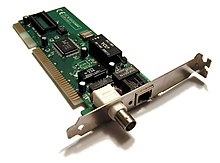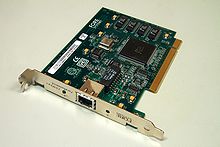Network card – Simple English Wikipedia, the free encyclopedia
A Network interface card (also known as a NIC, network card, or network interface controller) is an electronic device that connects a computer to a computer network , usually a LAN. It is considered a piece of computer hardware. Most modern computers support an internal network interface controller embedded in the motherboard directly rather than provided as an external component.
Network cards let a computer exchange data with a network. To achieve the connection, network cards use a suitable protocol, for example CSMA/CD. Network cards usually implement the first two layers of the OSI model, that is the physical layer, and the data link layer. There are older network protocols such as ARCNET, introduced in 1977, LocalTalk or Token Ring, but today, most network cards use Ethernet.

A network card, as it was common in the 1990s. This card was used for ethernet. It has both a 10Base2 connector for a coaxial cable and a 10BaseT connector for a twisted pair cable
Ethernet cards are available in several different standard packages called form factors that have evolved over the last several generations of PC hardware:
- In the 1990s and early 2000s, large Industry Standard Architecture cards were the first standard for PCs. Computer owners had to open the computer’s case to install the card.
- Newer Ethernet cards installed inside desktop computers use the Peripheral Component Interconnect standard and are usually installed by the manufacturer. These cards are still common in desktop PCs, for computers whose motherboards do not contain an onboard Ethernet port.
- Smaller Personal Computer Memory Card International Association Ethernet cards that resemble credit cards are readily available for laptop and other mobile computers. These insert conveniently into slots on the side or front of the device. The PC Card is a common PCMCIA device, although only certain PC Card and PCMCIA products support Ethernet. By the early 2010s, however, fewer laptops supported the PCMCIA standard.
- Though they look more like small boxes than cards, external USB Ethernet adapters also fill a market niche. These devices are a convenient alternative to PCI cards for desktop computers and they’re also commonly used with video game consoles and other consumer devices lacking PCMCIA slots and devices.

A network card, used for ATM
Networking speed
[
change
|
change source
]
Ethernet cards operate at different network speeds depending on the protocol standard they support.
Old Ethernet cards were capable only of the 10 Mbps maximum speed originally offered by the Ethernet standard. Modern Ethernet adapters support the 100 Mbps fast Ethernet standard and an increasing number now also offer gigabit Ethernet support at 1 Gbps (1000 Mbps).
An Ethernet card does not directly support Wi-Fi wireless networking, but home network broadband routers contain the necessary technology to allow Ethernet devices to connect using cables and communicate with Wi-Fi devices by means of the router.
The future of ethernet cards
[
change
|
change source
]
Ethernet cards ruled when cables remained the primary form of network access. Although Ethernet offers more reliable connections than wireless networking and therefore remains popular as a built-in option for desktop PCs and other relatively immobile computers, mobile devices including laptops and tablets have shifted away from Ethernet and toward Wi-Fi. The expansion of Wi-Fi services in workplaces, coffee shops, libraries and other public places has reduced the need for Ethernet cards.















![Toni Kroos là ai? [ sự thật về tiểu sử đầy đủ Toni Kroos ]](https://evbn.org/wp-content/uploads/New-Project-6635-1671934592.jpg)


